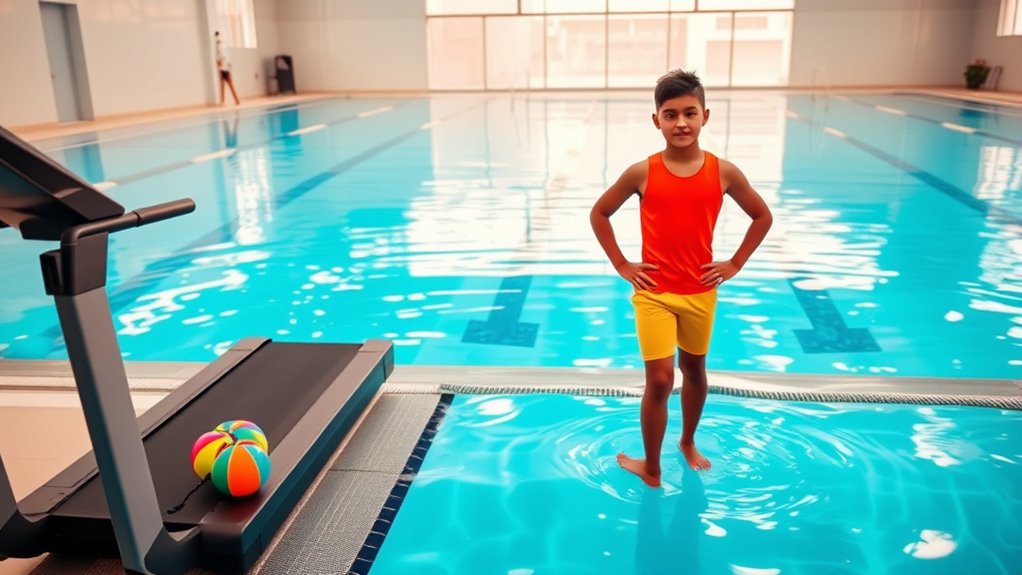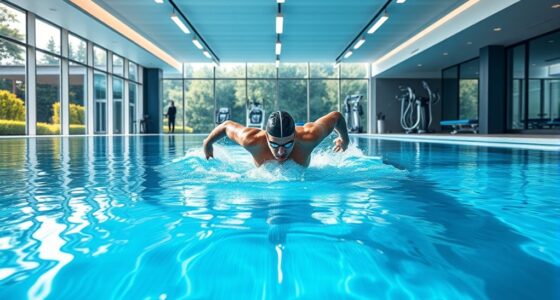If you’re new to pool workouts, start with gentle warm-ups, water walking, and low-impact exercises like side steps and knee lifts to build endurance safely. Incorporate stretches and strength moves using water resistance, focusing on all major muscle groups for a balanced routine. Always prioritize safety, listen to your body, and vary your exercises to stay motivated. Keep these key tips in mind, and you’ll discover more ways to enjoy effective, injury-free workouts in your Endless Pool.
Key Takeaways
- Start with gentle warm-up exercises outside and inside the pool to prepare muscles safely.
- Incorporate low-impact water walking, jogging, and stretching routines suited for beginners.
- Create balanced workouts targeting cardio, strength, and flexibility to promote overall fitness.
- Prioritize safety by checking equipment, maintaining proper form, and avoiding overexertion.
- Track progress, set goals, and vary routines to stay motivated and prevent workout boredom.
Getting Started With Your Endless Pool

To begin using your Endless Pool effectively, it’s important to familiarize yourself with its features and setup. First, read the user manual thoroughly to understand how to operate the controls, including temperature adjustments, jet speeds, and timer functions. Next, verify the filtration system and pumps are working correctly, and check the water level. Set up the pool in a safe, level area with proper electrical connections. Before diving in, test the water temperature to confirm it’s comfortable for swimming. Keep essential safety gear nearby, like a pool ladder or handrails if available. Take some time to explore the control panel so you can easily adjust settings during your workouts. Knowing your pool’s features helps you maximize safety and efficiency from the start, especially considering water circulation plays a vital role in maintaining water quality.
Warm-Up Exercises to Prepare Your Body
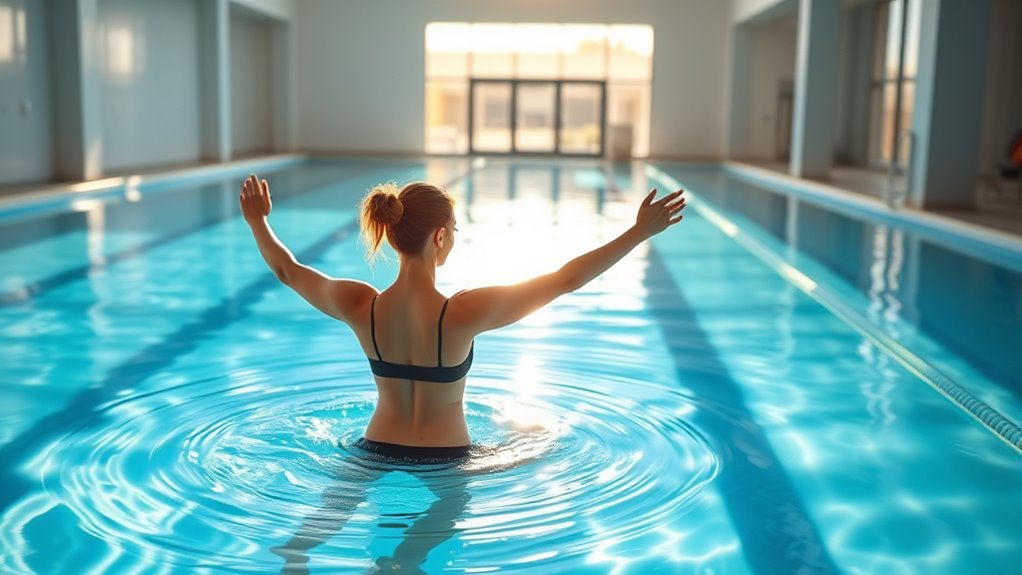
Before jumping into your swimming workout, taking time to warm up helps prepare your muscles and reduce the risk of injury. Start with gentle movements outside the pool, like arm circles, shoulder rolls, and neck stretches, to loosen up your upper body. Then, do light dynamic stretches such as leg swings and torso twists to activate your core and lower body. Once in the pool, begin with slow, easy swimming or water walking to gradually increase your heart rate. Focus on smooth, controlled motions to assure your muscles further. These exercises help improve circulation, increase flexibility, and guarantee your body is ready for more intense activity. Taking a few minutes for warm-up sets the stage for a safer, more effective workout.
Low-Impact Cardio Routines for Beginners
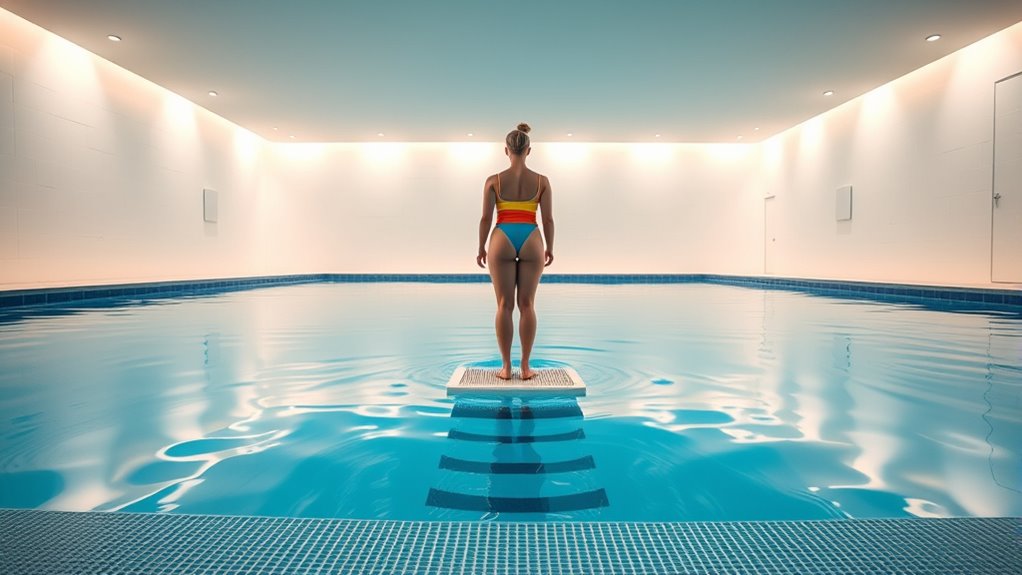
If you’re new to pool workouts or prefer a gentler approach, low-impact cardio routines are an excellent way to get started. These workouts boost your heart rate without stressing your joints. You can perform simple movements like walking in the water, gentle jogging, or side steps. To keep your routine engaging, try varying speeds and directions. Here’s a quick overview:
| Exercise | Duration | Intensity |
|---|---|---|
| Water Walking | 5-10 minutes | Light |
| Gentle Jogging | 5-8 minutes | Moderate |
| Side Steps | 3-5 minutes | Low |
| Knee Lifts | 3-5 minutes | Light |
| Arm Swings | 2-3 minutes | Gentle |
These routines help elevate your heart rate safely while building endurance. Incorporating low-impact exercises like these can also help you better understand your fitness levels and progress gradually.
Strengthening Movements Using the Pool
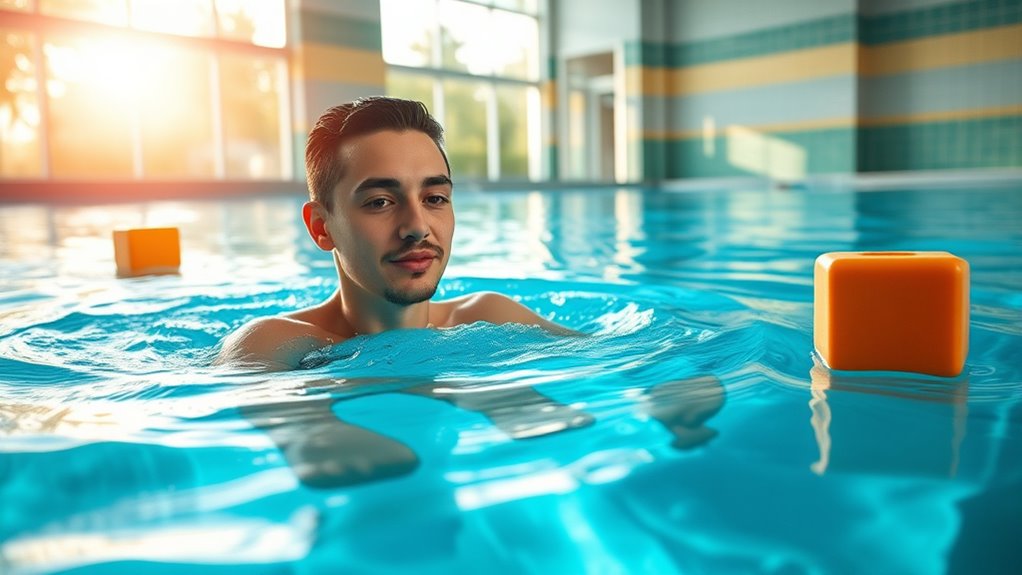
Using the pool for strength training offers the unique benefit of water resistance, making your movements more effective with less impact. You can modify bodyweight exercises to challenge different muscle groups, all while staying supported by the water. Plus, focusing on balance and core stability helps improve overall strength and coordination. Incorporating water resistance into your workouts can further enhance muscle engagement and progress.
Water Resistance Benefits
Water resistance in the pool provides a natural and effective way to build strength without stressing your joints. When you move against the water, it creates resistance, making your muscles work harder. This resistance helps improve muscle tone and endurance over time. Plus, it’s adaptable to your fitness level—simply increase your movement speed or change your range of motion for more challenge. Here are some key benefits:
- Enhances muscle strength through constant resistance.
- Improves joint stability with low-impact movements.
- Boosts endurance by engaging multiple muscle groups.
- Allows for versatile exercises targeting different areas. Yoga techniques can also be incorporated into pool workouts to improve flexibility and balance.
Bodyweight Exercise Variations
Bodyweight exercises in the pool are an effective way to strengthen muscles without equipment, leveraging the natural resistance of the water. You can perform movements like squats, lunges, and push-ups while standing in shallow water or using the pool’s edge for support. Water’s resistance challenges your muscles more than air, helping you build strength and endurance. Try submerged plank holds to engage your core, or perform leg lifts to target your hips and thighs. Moving through these variations increases muscle activation without added weights. Keep your movements controlled to maximize resistance. These exercises are versatile and gentle on joints, making them perfect for beginners. Incorporating resistance training into your routine can further enhance muscle strength and endurance while enjoying the soothing properties of water.
Balance and Core Focus
To effectively improve your balance and strengthen your core, incorporate targeted movements in the pool that challenge stability and engage your abdominal muscles. The water provides resistance and support, making exercises safer and more effective. Focus on exercises that require you to maintain stability while moving. Here are four exercises to try:
- Standing one-leg balance: Stand on one leg, lift the other, and hold. Keep your core tight.
- Water planks: Hold a plank position with your hands or forearms on the pool edge, engaging your core.
- Treading water: Use controlled, deliberate movements to stay afloat, activating your core and leg muscles.
- Seated twists: Sit on the pool floor, twist your torso side to side, engaging obliques.
These exercises help develop stability, balance, and core strength efficiently.
Flexibility and Stretching in the Water
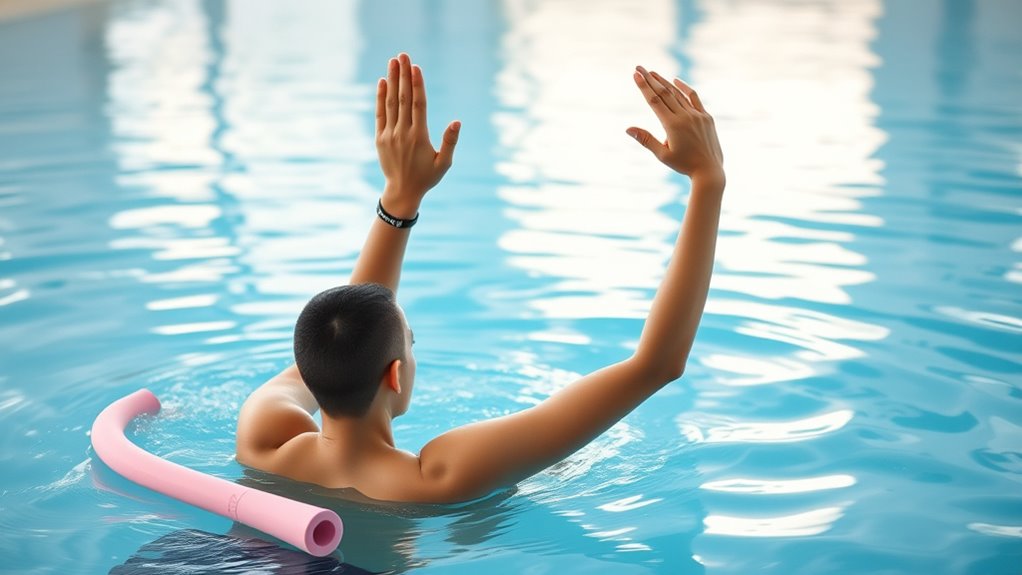
Water-based stretches are gentle but effective for increasing your flexibility. They help improve your range of motion without putting stress on your joints. Incorporating these moves into your routine can enhance overall mobility and comfort. Additionally, practicing natural language processing techniques can help you better understand your body’s responses and optimize your stretching routine.
Gentle Water Stretches
Gentle water stretches provide an excellent way to improve flexibility and reduce muscle tension without putting stress on your joints. The buoyancy of the water supports your body, making stretches smoother and safer. To get started, try these simple stretches:
- Standing Side Stretch: Reach one arm overhead and lean to the opposite side, feeling the stretch along your torso.
- Chest Opener: Clasp your hands behind your back and gently lift them, opening your chest.
- Hamstring Stretch: Extend one leg forward, heel on the pool floor, and gently lean forward.
- Neck Release: Slowly tilt your head from side to side, relaxing your neck muscles.
Perform each stretch slowly, holding for 15-20 seconds, and breathe deeply to maximize benefits. Incorporating celebrity lifestyle insights can enhance your motivation and enjoyment in your water workout routine.
Improve Range of Motion
Enhancing your range of motion in the pool helps increase flexibility and reduce stiffness, making everyday movements easier. Water’s supportive environment allows you to stretch safely without risking injury. To improve flexibility, focus on dynamic stretches like arm circles, leg swings, and torso twists, all performed in the water. Incorporate slow, controlled movements to promote muscle elongation. Use the resistance of the water to challenge your muscles gently, increasing flexibility over time. Consistency is key—try to include these stretches in your routine several times a week. As you progress, increase the range of motion gradually. Water’s buoyancy reduces joint impact, so you can push your limits comfortably. Improving your range of motion not only enhances your pool workouts but also benefits your daily mobility.
Creating a Balanced Workout Plan
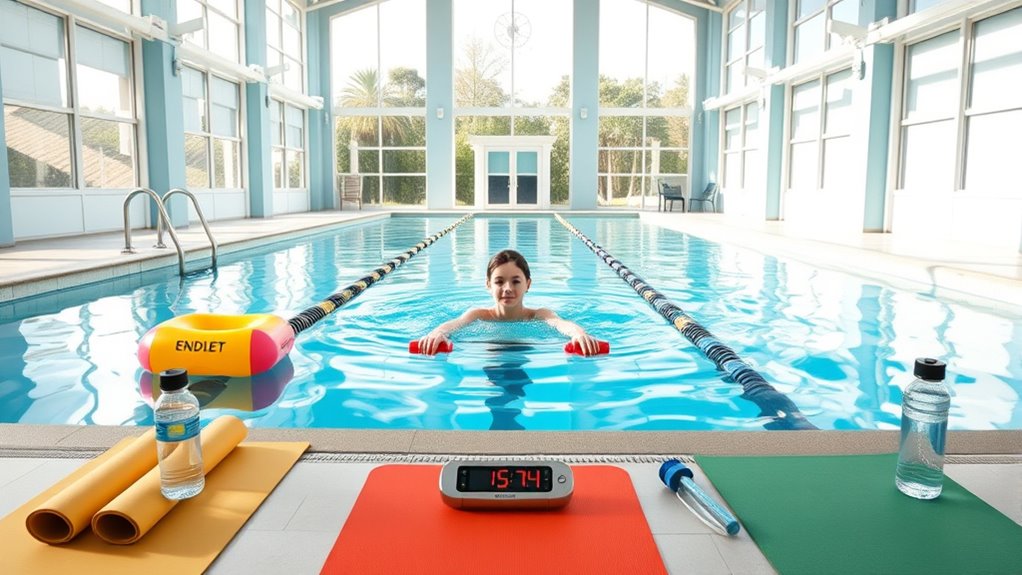
Creating a balanced workout plan for your endless pool sessions guarantees you target all major muscle groups while preventing fatigue or injury. To do this effectively, consider incorporating a variety of exercises and intensities. You are trained on data up to October 2023, which includes insights into effective workout strategies and the importance of muscle group targeting for overall fitness. 1. Include cardio, like steady swimming or water jogging, to boost endurance. 2. Add strength exercises such as water dumbbell curls or leg kicks to build muscle. 3. Mix in flexibility stretches to improve range of motion and prevent tightness. 4. Vary your pace and duration to avoid plateaus and keep your workouts engaging.
Tips for Staying Motivated and Consistent
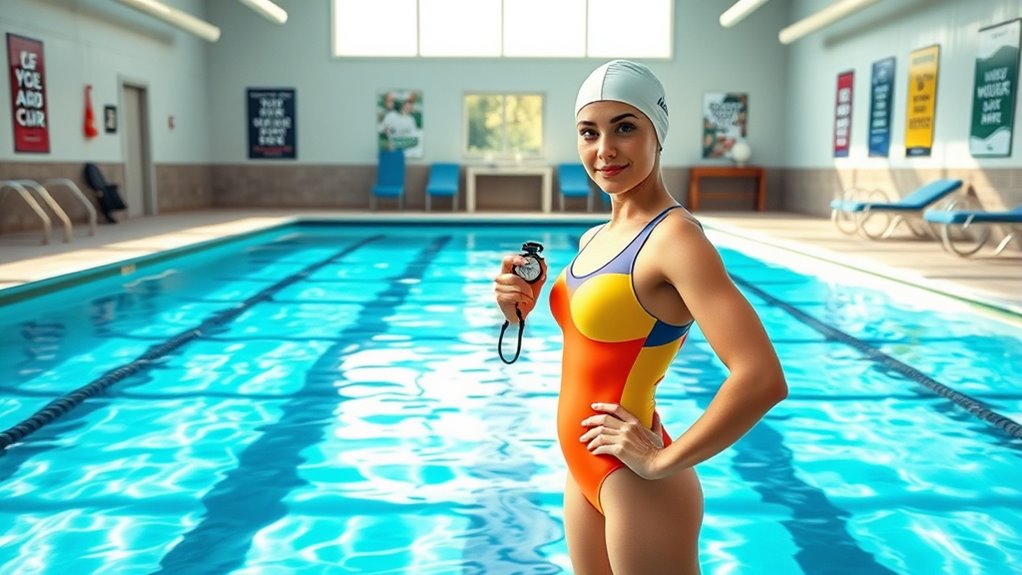
Staying motivated and consistent with your endless pool workouts can be challenging, but setting clear goals and tracking your progress makes a significant difference. When you know what you want to achieve, it’s easier to stay focused. Celebrate small milestones to keep your enthusiasm high. Additionally, mixing up your routines prevents boredom and keeps you engaged. Find a workout buddy or join a community to stay accountable. Use this table to set your goals and track your achievements:
| Goal | Action Step | Progress |
|---|---|---|
| Improve endurance | Swim 3 times a week | Completed 2/3 weeks |
| Increase speed | Add interval training twice a week | Ongoing |
| Maintain consistency | Log workouts daily | 10 days in |
| Stay motivated | Reward yourself after milestones | Planned |
Incorporating sound vibrations into your routine can also enhance your motivation and relaxation during workouts.
Safety Guidelines for Pool Workouts
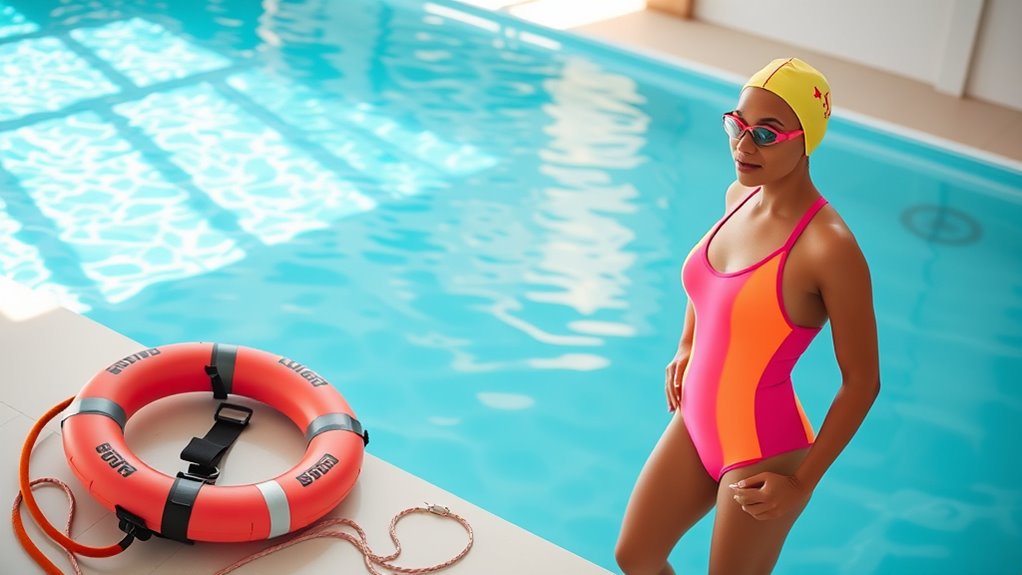
Maintaining motivation and consistency in your workouts is important, but ensuring safety should always come first. To stay safe during pool workouts, follow these guidelines:
Prioritize safety first to enjoy effective, injury-free pool workouts.
- Always warm up and cool down to prevent injuries.
- Never swim alone; have someone nearby or use a safety alarm.
- Stay within your skill level; avoid pushing too hard too fast.
- Keep the pool area dry and free of obstacles to prevent slips and falls.
Pay attention to your body. If you feel dizzy, tired, or uncomfortable, stop immediately. Use proper form and equipment to avoid strain. Regularly check your pool’s equipment for safety and maintenance. Prioritizing safety allows you to enjoy your workouts while minimizing risks.
Frequently Asked Questions
Can I Use an Endless Pool if I Have Joint Problems?
Yes, you can use an endless pool if you have joint problems. The water provides low-impact exercise, reducing stress on your joints while still giving you a good workout. Just make sure to start slow and consult your doctor beforehand. You might also consider adjusting the water temperature or using flotation devices to further protect your joints. Listen to your body and avoid overexertion for a safe, enjoyable experience.
How Often Should Beginners Swim in the Endless Pool Weekly?
You should swim in the endless pool two to three times a week to build endurance without overdoing it. But don’t rush—listen to your body and adjust as needed. Each session should last about 20 to 30 minutes, giving your joints time to recover. Missing a day here and there is okay; consistency is key. Stay patient, and you’ll see progress without risking injury.
Are There Specific Exercises Suitable for Pregnant Beginners?
Yes, there are safe exercises for pregnant beginners. You should focus on gentle swimming, such as slow, steady laps or water walking, which reduce joint strain and support your changing body. Avoid vigorous movements or breath-holding exercises. Always listen to your body and consult your healthcare provider before starting any new workout routine. Staying hydrated and avoiding overheating are also important for a safe and comfortable swimming experience during pregnancy.
What Should I Wear During Water Workouts as a Beginner?
You should wear a comfortable, well-fitting swimsuit that offers good support, especially if you’re pregnant. Consider a suit with built-in support or a maternity swimsuit for added comfort. Don’t forget a waterproof swim cap if you have long hair, and use goggles to protect your eyes. The right attire keeps you focused on your workout and ensures you move safely, but the real secret is finding what feels best for your body.
How Do I Track Progress in My Endless Pool Workouts?
To track your progress, start by noting your workout duration, distance, and intensity each session. Use a waterproof fitness tracker or swim-specific app to log your data. Keep a workout journal to record how you feel and any improvements over time. Regularly review your logs to see your progress, set new goals, and stay motivated. Consistent tracking helps you understand your improvements and keeps your workouts focused.
Conclusion
Starting with endless pool workouts can boost your fitness and confidence. Did you know that water-based exercises can burn up to 500 calories an hour? With consistent effort, you’ll see progress and enjoy improved strength, flexibility, and endurance. Remember to follow safety guidelines and stay motivated. Immerse yourself gradually, and you’ll discover how enjoyable and effective water workouts are—making your fitness journey both fun and rewarding!
